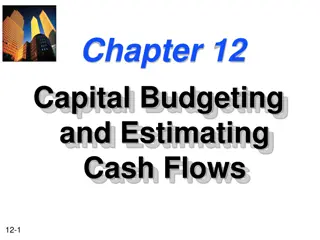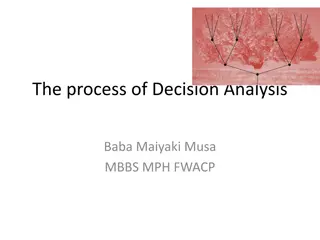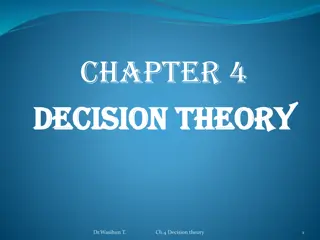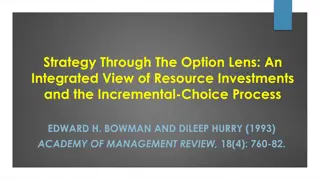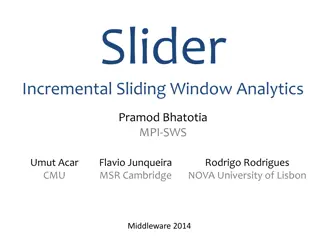Understanding Incremental Analysis and Business Decision Making
Incremental analysis is crucial in making informed business decisions by considering incremental revenue, cost, opportunity cost, sunk cost, and out-of-pocket cost. Relevant information to decision-making involves identifying and evaluating both qualitative and quantitative financial information. Managers must make decisions based on the differentiation between costs incurred and revenues earned, known as incremental revenue. By analyzing incremental costs and revenues, businesses can determine the best course of action to maximize profits and minimize losses.
- Incremental analysis
- Business decision making
- Relevant information
- Qualitative and quantitative data
Download Presentation

Please find below an Image/Link to download the presentation.
The content on the website is provided AS IS for your information and personal use only. It may not be sold, licensed, or shared on other websites without obtaining consent from the author. Download presentation by click this link. If you encounter any issues during the download, it is possible that the publisher has removed the file from their server.
E N D
Presentation Transcript
Faisal Acc 301 (Chapter #20) faisal.faisal@neu.edu.tr
Incremental Examination Analysis Relevant information to business decision Incremental revenue Incremental cost Incremental Analysis Opportunity cost Sunk cost Out of pocket cost
BUSINESS DECISION Spiral order decision Production constraint decision Make a big decision Joint product decision
Relevant information to decision making Here one identifies all relevant financial information from business decision. Decisions are whether rejected or accepted related information regarding decision You must understand the qualitative and quantitative information on the basis of judgment we can accept or reject decision if without using qualitative and quantitative information.
Continue Manager work is not judgment but also have knowledge but must have knowledge of qualitative and quantitative information. We collect relevant financial information among different course of action which include cost and revenue. E.g., relevant financial information varies among different courses of action (if accepted or rejected). Cost and revenue if doesn t vary, it is not relevant financial information to decision.
Incremental Revenue Example: if university gets closed for one month due to strike but electricity bill will be there Rent will be there which is fixed cost and cleanup cost (E.g.) if is 2000 revenue rent is 10,000 for movie to make (Rent) Revenue .10, 000 Electricity bill 15, 000 Operating expenses ...17, 000 Operating loss .17, 000 /7, 000
Continue.. One the basis of relevant factors, i.e., incremental revenue is the differntiate between cost incurred and revenue earned) we make reject decision. (Accept and reject) 2 course of action. Incremental revenue is also known as differential revenue. Incremental cost differential cost Incremental revenue in both course of action can be and . Incremental analysis examines the difference between incremental cost and incremental revenue.
Continue Reject accept revenue 0 accept 10,000 Cost paid cost 15,000 accept 15,000 cleanup cost 0 accept 2000 operating cost 15000 accept 7000
Contniue Note: we have to pay whether accepted or rejected Incremental analysis 10,000 This is known as Incremental revenue or differential revenue. Incremental cost 0 Incremental cost 2000
Continue We examine both incremental cost and revenue that s 8,000.This decision was missing. After incremental analysis, you do your decisions. (Cost is covered by revenue).Except incremental revenue and cost you have to keep in mind the concept of opportunity cost and other while making decisions. Revenue that is 10,000 is sunk cost, which is not occurred for future decision. It is not important. For film industry 10,000 is sunk cost
Continue Out of pocket cost: For future cost. The cost is in future. E.g. cleanup cost. it can vary 2,000 etc. Special order decision: 10,000 per day if special order is of 20,000 units have to be manufactured have to made decision whether to accept order of reject.
Production constraints: Whether engineer purchased for resale or manufactured product make and buy. Furniture tool: Whether by that tool and one should purchase that Joint product From one product, different products comes out Diesel, gas petrol Joint product cost Decision for this we do incremental analysis.







